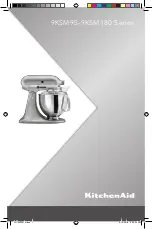
14
| TIPS FOR GREAT RESULTS
TIPS FOR GREAT RESULTS
MIXING TIPS
Mixing time
Your KitchenAid Stand Mixer will mix
faster and more thoroughly than most
other electric mixers� Therefore, the
mixing time in most recipes must be
adjusted to avoid over-beating�
To help determine the ideal mixing time,
observe the batter or dough and mix
only until it has the desired appearance
described in your recipe, such as “smooth
and creamy�” To select the best mixing
speeds, use the “Speed control guide”
section�
Adding ingredients
The standard procedure to follow when
mixing most batters, especially cake and
cookie batters, is to add:
1/3 dry ingredients
1/2 liquid ingredients
1/3 dry ingredients
1/2 liquid ingredients
1/3 dry ingredients
Use Speed 1 until ingredients have been
blended� Then gradually increase to
desired speed�
Always add ingredients as close to side of
bowl as possible, not directly into moving
beater� The pouring shield can be used to
simplify adding ingredients�
NOTE:
If ingredients in very bottom
of bowl are not thoroughly mixed, the
beater is not far enough into the bowl�
See the “Assembling the Stand Mixer”
section�
Cake mixes
When preparing packaged cake mixes, use
Speed 4 for medium speed and Speed 6
for high speed� For best results, mix for the
time stated on the package directions�
Adding nuts, raisins, or candied fruits
Solid materials should be folded in the last
few seconds of mixing on Speed 1� The
batter should be thick enough to keep the
fruit or nuts from sinking to the bottom of
the pan during baking� Sticky fruits should
be dusted with flour for better distribution
in the batter�
Liquid mixtures
Mixtures containing large amounts of
liquid ingredients should be mixed at lower
speeds to avoid splashing� Increase speed
only after mixture has thickened�
Kneading yeast doughs
ALWAYS use the dough hook to mix and
knead yeast doughs� Use Speed 2 to mix
or knead yeast doughs� Use of any other
speed creates high potential for unit
failure�
Do not use recipes calling for more
than 7 cups (900 g) all-purpose flour or
6 cups (800 g) whole-wheat flour when
making dough in a 4�28-L bowl�
Do not use recipes calling for more
than 8 cups (1 kg) all-purpose flour or
6 cups (800 g) whole-wheat flour when
making dough in a 4�8-L bowl�
W11225091B.indb 14
5/10/2018 6:35:28 PM















































